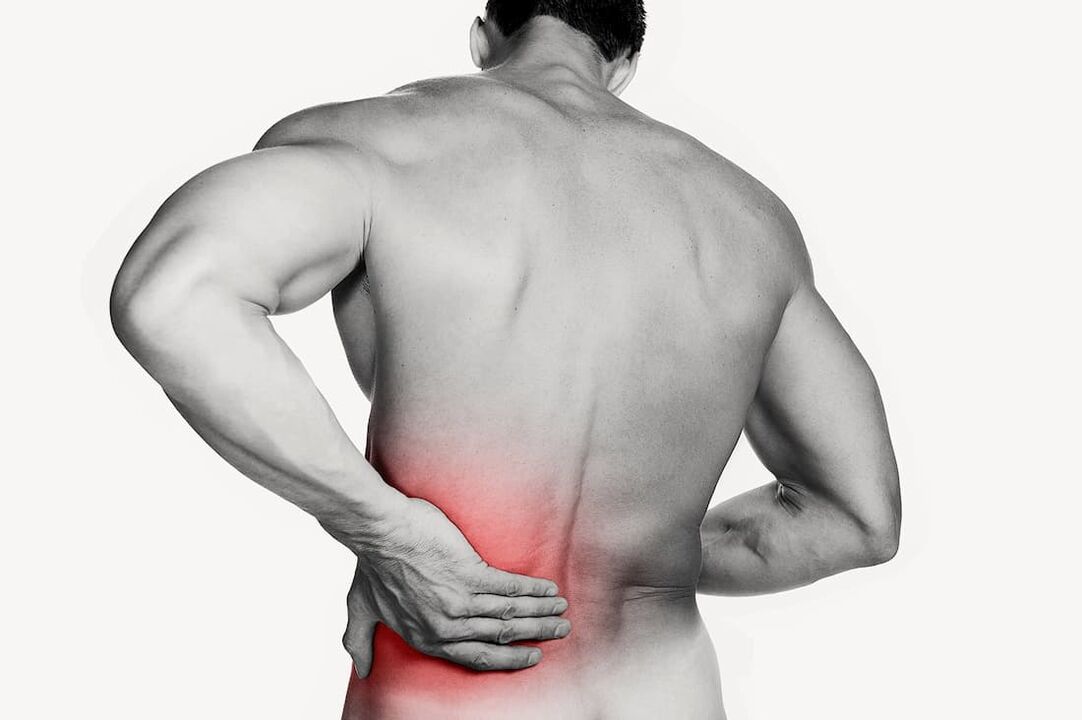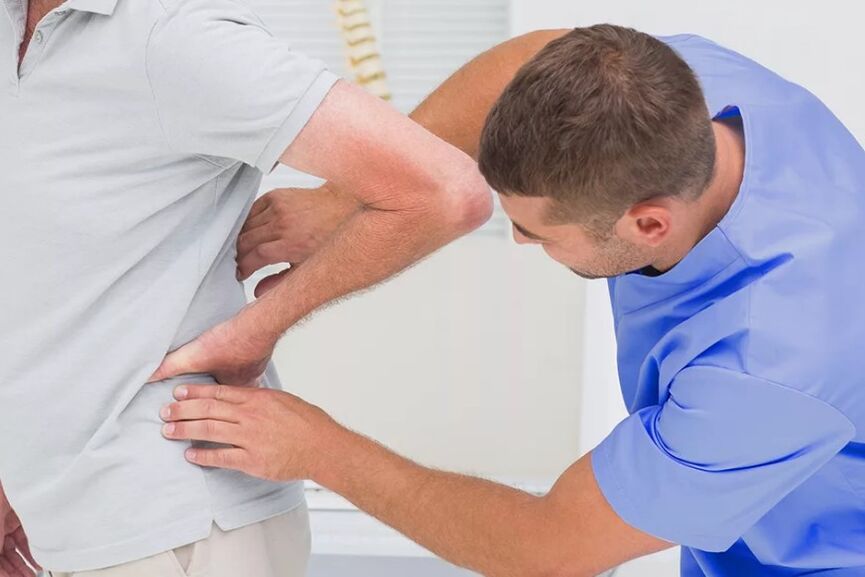
Lows pain is the symptom that is rarely paid.Most people associate them with working in a seated position, lifting weights or osteochondrosis and are not in a hurry to see a doctor.In fact, this disease can signal the diseases of the kidneys, liver or intestine, and problems with the musculoskeletal system are not directed alone.Only a timely review of a specialist and a complete examination helps to determine the cause of pain and choose the correct treatment.
General information
The lower back is an area with a considerable load because they are in an upright position.The spine is shown by five large vertebrae, which are also strengthened by the muscle frame.9 out of 10 cases of pain in this area are provoked exactly by the pathology of the musculoskeletal system: osteochondrosis, muscle pasmol, hernia of the intervertebral disc, clamping the nerve root.
The remaining 10% of the cases are associated with diseases of the internal organs in the projection of the lower back: kidneys, genitals, intestines, liver.Even a doctor cannot always determine the cause of the pain during the examination, which is why this state requires a thorough and instrumental diagnosis.
Types of pain
The first thing the doctor asks is is the type of sensations.Depending on the cause it caused, the lower back pain can be:
- Acute: Usually arises sharply, characterized by high intensity;The duration of the sensations is no more than 1.5 months;
- Subacute: The 6-12 weeks lasts;
- Chronic: sensations of all intensity that lasts 12 weeks or more;
- Transfer (variable): appears regularly;
- painful;
- dumb;
- Strong, average intensity, weak.
This department is conditional.Depending on the situation and the circumstances, the type and duration of the sensations can vary.It is important to describe them as completely as possible.
Reasons
The reasons why the back begins to hurt in the lower back.Most of the time, provocative factors serve:
- Settlement;
- Weightlifting;
- Uneven load distribution (against the background of pregnancy, posture disorders, pathology of the musculoskeletal system);
- Infectious lesion;
- Diseases of the musculoskeletal system;
- Inflammation processes, including autoimmune;
- long stay in an unpleasant position;
- Change of the composition of bone tissue (osteoporosis);
- Volume processes: benign and malignant tumors, abscesses;
- Hormonal changes (menstruation, pregnancy, menopause);
- Kidney diseases (urolithiasis, pyelonephritis, glomerulonephritis, abscesses);
- Pathology of the stomach intestine tract;
- Diseases of the uterus and attachments in women, prostate in men etc.
Diseases
Low's pain can be a symptom of different diseases of the musculoskeletal system and internal organs.The main task of the doctor is to find out what exactly causes the condition and took the necessary measures.
Here are pathologies that are most common.
Spondylitis Ankylosans
This is a systemic inflammatory disease in which individual vertebrae occurs in a single conglomerate.At the same time, a calcium deposit occurs in leagues that stabilize the spine, whereby the affected area almost completely loses mobility.
The characteristic characteristics of pain in the lower backrest with ankylosinus spondylitis include:
- an increase in intensity in peace, especially in the event of a longer finding in a horizontal position;
- Restriction of movements in the lumbar spine;
Osteochondrosis of the lumbar spine
This is a very common disease in which the intermittent slices are thinner and perform the role of shock absorbers.As a result, nerve roots and cramps of the surrounding muscles that cause severe pain are irritated.In the late stage of the disease, a hernia of the intervertebral disc that presses on the spinal cord and improves the pain is improved.
The pain increases with osteochondrosis:
- when lifting a seated or horizontal position;
- When trying to lie on the stomach;
- With inclinations.
If the disease causes the formation of a massive hernia, the pain in the lower back is often accompanied by deafness and either the weakness of one or both legs.
The curvature of the spine in the lumbar region (kyphosis, scoliosis)
Pain in this pathology occurs in the middle and late stage of the development of the disease.The discomfort usually occurs at the end of the day and is often accompanied by the tiredness of the spine muscles.The pain is caused more often by the cramps of the muscles of the spine, and it is also possible to explore the muscles at the distance (gluteal, periosemantal muscles of the upper and lower extremities).
Spondylarthrosis
This is a degenerative-dystrophic cartilage disease that covers intervertebral slices.It is gradually thinner and destroyed, bone growth (osteophytes) appear in the area of the lesion.As a result of a reduction of the distance between the vertebrae, the narrow vertebral canal, the nerve roots and the spinal cord are irritated.
Pain with this pathology:
- intensified after the load (long -term stay in a standing position, go) and goes to rest;
- Accompanied by stiffness of movements, first in the morning and then constant;
- It can be given to the thigh and the surface of the hip joint.
The muscles in the area of the lesion are convulsive and constantly in tension, which also increases the pain.
Urolin disease
An attack by urolithiasis is characterized by severe lumbar pain from the affected kidney.At the same time, the sensations do not change depending on the pose, a person cannot find a position in which they are at least a little weaker.The attack is often accompanied by a reduction in the amount of urine and a change in its color to the red hearing.
Lows pain can also be a result:
- Algoma (painful menstruation);
- Pregnancy;
- Pancreatitis;
- Osteomyelitis;
- Intestinal engineering;
- Appendicitis etc.
Pain in different parts of the back
The localization of pain can say a lot about your cause.Pain in the upper part of the lumbar industry can be a result:
- Spinal diseases;
- Injuries;
- Muscle cramp against the background of their overvoltage;
- Cardiovascular diseases;
- Tumors;
- Diseases of the gastrointestinal tract.
If the epicenter is at the end of the lower back, the list of probable reasons includes in addition to the spine diseases:
- Renal pathology (pyelonephritis, urolithiasis);
- Intestinal disorder (constipation, flatulence);
- Cramps or inflammatory process in the pelvic organs (salpingoophorite, endometritis);
- In particular physiological causes;
- Press the sciatic nerve.
The shifting of pain to the right or left can indicate the lesion of the corresponding spine of the spinal cord, kidneys.
Diagnosis
The diagnosis of pain in the lower back area requires a comprehensive examination.The first phase of searching for the reason is the survey.The doctor clarifies:
- Localization of the pain;
- His character and duration;
- Causes that cause an attack or improve pain;
- Circumstances under which the disease improves (a certain pose, immobility, drugs, etc.).
Data on injuries and illnesses, already identified chronic pathologies, are recorded without failure.Another possible diagnostic search for the doctor's discretion includes:
- General test of blood and urine: helps to identify the inflammatory process in the body, kidney pathology;
- Biochemical blood test to determine signs of kidney damage, pancreas, liver and gallbladder, etc.;
- Ultrasound of the abdominal organs and the pelvis in men - ultrasound of the prostate;
- Ultrasound of the kidneys;
- Radiography, CT or MRI of the lumbar spine;
- X -Ray the breast.
In the event of suspicion of a pathology after a review of the diagnosis and inspection, more targeted tests, studies and consultations by narrow specialists are prescribed.They enable them to clarify or refute the diagnosis.

Treatment
The treatment of pain in the lower back depends on its cause.A neurologist, a urologist, a gynecologist and a surgeon can get involved in a pathology.When it comes to diseases of the musculoskeletal system, doctors use medical, non-drug and surgical methods to improve the patient's condition.
Drug treatment
The most common means of eliminating lumbar pain are not steroids anti -inflammatory drugs (NSAIDS).They are prescribed in the form of tablets, intravenous and intramuscular injections, rectalic acids as well as creams, ointments and plasters for local use.The decision is made by the doctor's dosage and the duration of the course, since the uncontrolled use of these medication can cause unpleasant side effects.
If the NSAIDs are ineffective, the doctors prescribe hormonal medication (corticosteroids).They also stop the inflammatory process and contribute to reducing the pain.
The third group of medication that improves the patient's condition is antipas modos.They remove muscle cramps in the lower back.
In addition, they can be appointed:
- Value to reduce edema of a pinched root;
- B -vitamine to improve the nerve line;
- Seastant.
Not -drug methods
Not -drug treatment supplements medical systems.Depending on the clinical situation, it can be of it:
- Physiotherapeutic methods (magnetotherapy, laser effect, electrophoresis, etc.);
- Physiotherapy exercises: The course of the exercises is developed individually in accordance with the main and related diseases.The gymnastics should be carried out regularly, not only in the clinic's office, but also at home, only in this case it affects.
- General strengthening and therapeutic massage (outside of exacerbations);
- Acupuncture;
- Manual therapy and support for Osteopath.
Surgical treatment
The surgeon's helper is required if the treating doctor reveals one of the indications for surgical treatment on the basis of the general image.The presence of a hernia of the intervertebral disc, regardless of its size, is no indication of surgical treatment.Depending on the information, doctors can remove the hernia of the intervertebral disc, remove the compression of the roots of the spinal cord, remove the tumor, etc. The decision to carry out a certain operation is done individually.
prevention
The most effective way to avoid pain in the lower back is to adapt your lifestyle to save the kidneys, the spine and the pelvic organs.However, if the pain often arose, this should be the reason for an extraordinary appeal to a specialist:
- Avoid hypothermia;
- Prevent hypodynamy;
- Sport sport at amateur level (swimming is particularly advantageous the condition of the spine and the back muscles);
- To eat correctly and balanced: prevent overmearing, fat, spicy, excessive salted, minimize food;
- Exclude alcohol and nicotine;
- Drink at least 1.5 liters of pure water every day without taking tea, coffee or juices into account;
- Keep the body mass index at the normal level: excess weight does not affect the condition of the spine, and the deficiency can cause kidney worship.
If a person has already diagnosed the pathology of the musculoskeletal system, preferably at least twice a year, according to European recommendations for the rehabilitation of the pathology of the spine in order to undergo prices that are prevented before the appointment of a doctor.
























